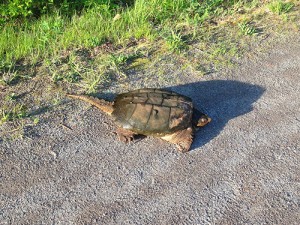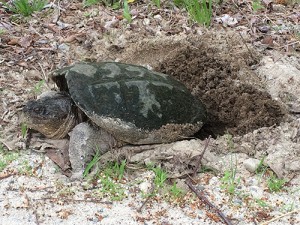Have you ever hesitated before leaping into a pond for fear of snapping turtles? Just when you are about to plunge, somebody has to mention that the pond is full of snappers?
I admit to having experienced that fear, even though I have always jumped in anyway and have never had a bad encounter with a snapping turtle. I have been thinking about those turtles this summer, as many Beacon readers have been reporting encounters with these prehistoric-looking reptiles and sending some photos, especially from along the Rail Trail. I decided to learn more about Chelydra serpentina and try to separate the facts from the myths.

The common snapping turtle has a reputation for being fierce, short-tempered, and aggressive, but this impression comes primarily from humans coming too close to them on land. In water, they are shy and will do whatever they can to avoid interaction with humans – and they are mostly in water.
Snapping turtles live in rivers, marshes, ponds, and lakes, preferring a slow-moving waterway with a soft bottom of sand or mud. While they are omnivorous, the snapper’s diet is mostly made up of algae, plants, and carrion at the bottom of ponds. They also eat frogs, small turtles, snakes, insects, crayfish, and fish.
Even though they are capable swimmers, they mostly move by walking along the bottom. Unlike other turtles, they rarely bask on logs, but they sometimes float just below the water’s surface.
So why would a snapping turtle be on land? Either its pond dried up, and it is seeking new habitat; it is a female involved in laying eggs; or it is a young hatchling doing its best to get to water.
Because they have a small upper shell (carapace) and really small plastron (lower shell), snappers cannot full retract their head and legs; therefore, they are highly vulnerable on land and naturally aggressive when approached. They will hiss and snap to warn off potential danger.
What if you see a snapper crossing a road? Should you try to help? Experts urge the rest of us to avoid any contact with a snapping turtle, for the turtle’s sake and ours.
Do not try to pick it up! The snapper’s neck is long and flexible (hence the species name serpentina) – it can bite way back by its hind legs. Some people think it’s OK to move a snapping turtle by grabbing the tail and either dragging the turtle or picking it up. But the tail is an extension of the spine, so lifting or dragging will do damage to the vertebral column and possibly injure its underside. Possibly you can help by staying in the area to divert traffic; otherwise, stay away.

A female can travel a long distance to find just the right sandy spot to lay her eggs. Typically she lays 20 to 40 ping-pong ball sized eggs which require a gestation period of 9 to 18 weeks. She leaves immediately after covering the nest. Only about 1% of the eggs will ever hatch because of predators, including raccoons, foxes, and skunks.
Ancestors of the snapping turtles we know were here with the dinosaurs. I’ve decided to stop being afraid of snappers and instead look forward to rare glimpses (from afar) of these ancient creatures.